Bb1-1 could possibly, according to my tentative
interpretations, have corresponded to January 1:
|
koia kua here i to reva ika |
kua huka ia - i to maro |
na te tagata kua oho |
ki to haga |
e tagata rave ra |
|
Reva, to hang down;
flag, banner. Revareva,
1. To be hanging vertically; to
detach oneself from the
background of the landscape,
such a person standing on top of
a hill: ku-revareva-á te
tagata i ruga i te maúga. 2.
To cast itself, to project
itself (of shadows);
revareva-á te kohu o te miro i
te maeha o te mahina, the
shadow of the tree casts itself
in the light of the moon. 3.
Uvula. Vanaga. To hang, to
suspend, flag, banner;
hakareva, to hang up;
hakarereva, to hang up, to
balance; hakarevareva, to
wave. T Pau.: reva, a
flag; fakarevareva, to
hang up, to suspend. Mgv.:
reva, a flag, a signal. Mq.:
éva, to hang up, to be
suspended, to wave a signal.
Ta.: reva, a flag,
banner; revareva, to
wave. The germ sense is that of
being suspended ... any light
object hung up in the island air
under the steady tradewind will
flutter; therefore the
specification involved in the
wave sense is no more than
normal observation. Churchill.
Mgv.: 1. A plant. Ta.: reva,
id. Mq.: eva, id. Sa.:
leva, id. Ma.: rewa-rewa,
id. 2. To cross, to pass across
quickly; revaga,
departure. Ta.: reva, to
go away, to depart. Ma.: reva,
to get under way. Churchill.
Ta.: The firmanent, atmosphere.
Ha.: lewa, the upper
regions of the air, atmosphere,
the visible heavens. Churchill.
Ta.: Rave,
to take. Sa.: lavea, to
be removed, of a disease. To.:
lavea, to bite, to take
the hook, as a fish. Fu.:
lave, to comprehend, to
seize. Niuē:
laveaki,
to convey. Rar.: rave,
to take, to receive. Mgv:
rave,
to take, to take hold;
raveika,
fisherman. Ma.: rawe,
to take up, to snatch. Ha.:
lawe,
to take and carry in the hand.
Mq.: ave,
an expression used when the
fishing line is caught in the
stones. Churchill 2. |
 |
 |
 |
 |
 |
|
Bb1-1
(422 → 4 * 22) |
Bb1-2 |
Bb1-3 (424) |
Bb1-4 |
Bb1-5 (365 + 61) |
|
.. Lifting a huge doorstone,
such as two and twenty good
four-wheeled wains could not
have raised from the ground,
he set this against the mouth of
the cave, sat down, milked his
ewes and goats, and beneath each
placed her young, after which he
kindled a fire and spied his
guests
... |
|
Jan 1 (89 - 88) |
2 |
3 |
4 |
5 |
78 would then correspond to
March 19 and 121 to May 1:
|
a1 |
47 |
47 |
b1 |
31 |
31
= 5 + 26 |
|
a2 |
40 |
87 |
b2 |
47 |
78
= 2 * 39 |
|
a3 |
37 |
124 |
b3 |
43 |
121
= 11 * 11 |
|
a4 |
40 |
164 |
b4 |
42 |
163 |
|
a5 |
43 |
207 |
b5 |
40 |
203 |
|
a6 |
44 |
251 |
b6 |
40 |
243 |
|
a7 |
43 |
294 |
b7 |
41 |
284 |
|
a8 |
46 |
340 |
b8 |
42 |
326 |
|
a9 |
49 |
389 |
b9 |
39 |
365 |
|
11 |
376 |
|
a10 |
32 |
421 |
b10 |
42 |
418 |
|
389 + 365 = 400 + 354. |
b11 |
43 |
461 |
|
b12 |
45 |
506 |
|
sum |
421 |
sum |
506 |
49 was the number of notches on the
back side of the ancient mammoth
bone with the figure of Rigel (*78)
on its front side (his arms held
high similarly to those of the
bird in Bb1-5),

that bone which carried 39
notches (which should remind us of the
variants of uhi stolen by
Teke from his brother Ma'eha
→ 2 * 39 = 78)
on its border between the back and
the front
side.
|
Takapau |
39 variants of uhi - STOLEN
by Teke from his brother
Ma'eha [E:58-64] |
|
 |
*19 |
 |
*14 |
 |
*8 |
 |
|
SIRRA H
(*0) |
ADHIL (*19) |
MIRA (*33) |
BHARANI (*41) |
|
ALCHITA (*183) |
SPICA (*202) |
KHAMBALIA (*216) |
ZUBEN ELGENUBI (*224) |
|
0h |
39 (= 3 * 13) |
365 + 389 = 400 + 354 = 4 * 100 + 4
* 88½.
Presumably the counting of star
domains ('sheep') in the
night went on past the last glyph on
side a and on to the first glyph on
side b. If so, then the December
solstice could correspond to the
bird with an empty eye socket crying
out in Bb9-29 (421 + 355 = 776 = 754
+ 22):
... On the late
afternoon of the June solstice, towards
sunset, we reached Ahu Akivi near
the centre of the western side of Easter
Island. This is an inland site, 3
kilometers from the coast.

Like Ahu
Nau Nau at Anakena, it has
seven Moai, but in this case none
of them have topknots and, uniquely, all
face west towards the sea - which is
clearly visible from the high point on
which they stand.
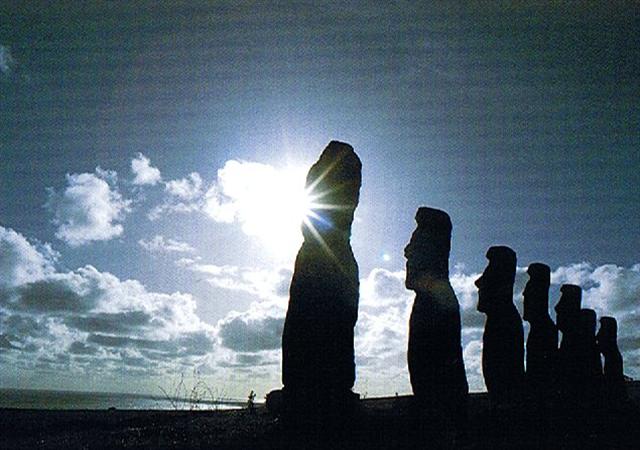
There is a curious tradition concerning
these grizzled, otherworldly statues,
solemn and powerful, with their blank,
aloof eye-sockets gazing out over the
limitless ocean. Like most of the other
Moai of Easter Island the local
belief is that they died, long ago, at
the time when mana - magic -
supposedly fled from the island never to
return. However, in common with only a
very few of the other Moai, it is
believed that these particular statues
still have the power, twice a year, to
transform themselves into aringa
ora - literally 'living faces' -
a concept startingly similar to the
ancient Egyptian notion that statues
became 'living images' (sheshep ankh)
after undergoing the ceremony of the
'opening of the mouth and the eyes'.
Statues at Angkor were likewise
considered to be lifeless until their
eyes had been symbolically 'opened'
...
| kua
hahaú ia koia |
e rere
koia |
ki
ruga mai kia au |
kua
rere mai ki te toga |
eaha
te manu rere toki - ki te
henua |
eaha
te manu rere |
ki te
hokohuki |
|
 |
 |
 |
 |
 |
 |
 |
|
Bb9-28 |
Bb9-29 (355) |
Bb9-30 |
Bb9-31 |
Bb9-32 |
Bb9-33 |
Bb9-34 (360) |
|
Dec 20 |
SOLSTICE |
22 |
23 |
X-MAS EVE |
25 |
26 |
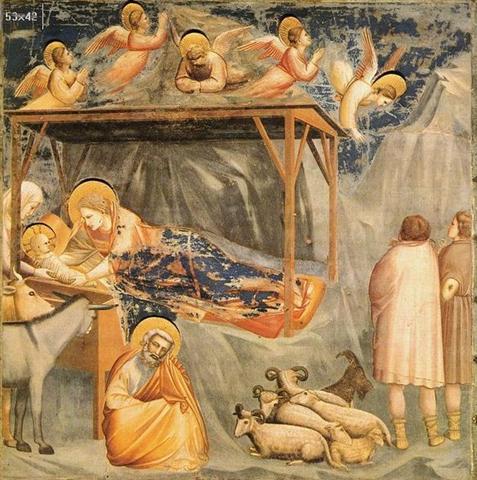 |
| kua
haga i te mea ke |
ki te
tuuga o to toga |
e
tagata rere |
mai ki
te totoga e |
kua
haga ko te mea ke |
o
tagata itiiti |
kua
moe mai kia ia - kua moe i
te ragi |
kua
hua ia mai - ki te henua |
|
Iti.
Little, small, medium;
iti atu, less; iti no,
small quantity, rare; no
iti, superficial.
Itia, shrunken.
Itiiti, scanty, slim;
hare itiiti no, cabin;
itiiti noa, mediocre,
mediocricity. Hakaiti,
to make small, to lessen, to
weaken, to impoverish, to
thin out, to reduced, to
diminish, to retrench, to
curtail, to subdue, to
mitigate, to abate.
Hakaitiiti, to squat, to
croach. P Mgv.: iti,
small. Mq.: iti, id.
Ta.: iti, id.
Churchill. |
 |
 |
 |
 |
 |
 |
 |
 |
|
Bb9-35 |
Bb9-36 |
Bb9-37 |
Bb9-38 |
Bb9-39
(365) |
Bb9-40 |
Bb9-41 |
Bb9-42 |
|
Dec 27 |
28 |
29 (363) |
30 |
31 |
1 (89 - 88) |
Jan
2 |
3 |
It seems significant to find Christmas
Eve at the glyph which exhibits a kind
of creation:
|
 |
 |
 |
|
Ga3-2
→ 4 * 64 = 256 |
Bb9-32 →
288 = 4 * 72 |
Aa6-66
→ 396 = 4 * 99 |
|
64 + 8 = 72 = 99 - 27 |
The iconic numbers 256, 288, and
396, can be verified:
|
Counting in the
tresses of
Pacha-mama from
right to left: |
|
1 |
26 |
78 |
1 |
29 |
90 |
|
2 |
26 |
2 |
30 |
|
3 |
26 |
3 |
31 |
|
4 |
25 |
104 |
4 |
34 |
124 |
|
5 |
26 |
5 |
31 |
|
6 |
27 |
6 |
30 |
|
7 |
26 |
7 |
29 |
|
Total =
396
= 182 + 214 (= 364 +
32) = 390 + 6 |
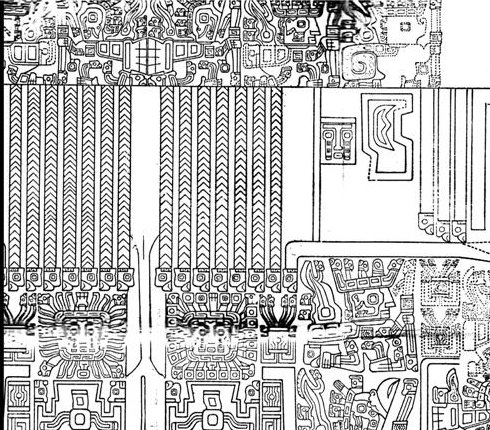
And when the Sun
in day 288 (= 2 * 144) reached
Benetnash in Ursa Major the Full
Moon would be at the right ascension
line closing up to the north pole
star (Polaris).
... Gregory
dropped 10 days to bring the
calendar back into synchronisation
with the seasons. Accordingly, when
the new calendar was put in use, the
error accumulated in the 13
centuries since the Council of
Nicaea was corrected by a deletion
of ten days. The Julian calendar day
Thursday, 4 October 1582 was
followed by the first day of the
Gregorian calendar, Friday, 15
October 1582 (the cycle of weekdays
was not affected) ...
... The canoes of
Ava Rei Pua and of Hotu
were seen near the (off-shore)
islets. On the fifteenth day of the
month of October (tangaroa
uri) the canoe of Hotu
and the canoe of Ava Rei Pua
landed. On the fifteenth day of the
month of October (tangaroa
uri), Nonoma left the
house during the night to urinate
outside. At this point Ira
called out to Nonoma, 'Look
at the canoe!' Nonoma ran, he
quickly went to Te Hikinga
Heru (a
ravine in the side of the crater
Rano Kau) and looked around.
There he saw the double canoe way
out near the (offshore) islets, and
the two (hulls of the canoe) were
lashed together. He ran and returned
to the front of the house. He
arrived and called into the house:
'Hey you! This canoe has arrived
during the night without our
noticing it!' Ira asked
Nonoma, 'Where is the canoe,
which you say is lying out there (in
the water)?'
Nonoma's
voice came back: 'It is out there
(in the water) close to the
(offshore) islets! There it lies,
and the two (hulls) are lashed
together.' The four of them
(corrected for 'the six of them')
went out and picked up leaves (on
branches) to give signals. They
picked them up, went and arrived at
Te Hikinga and saw the canoe.
Raparenga got up, picked up
the leaves, took them in his hands,
and waved, waved, waved, waved ...
[E:75]
As to Rotten
Cane it is hard not to think of
April 25 = May 22 (142) - 27 = April
9 + 16 (→ 3²
+ 4² = 5²) as the place
(Gb8-2) where the idea of a
swallowing mouth (vaha kai)
was half a year away at
Fom-al-Haut (the Mouth of the
Fish):
|
FEBR 19 (365 + 50) |
20 (*336) |
21 (417 → Bb4-17)
|
22 (53) |
TERMINALIA |
 |
 |
 |
 |
 |
|
Gb8-1 (229 + 213) |
Gb8-2 (443) |
Gb8-3 (444) |
Gb8-4 (2 * 108)
|
Gb8-5 |
|
April 24 (*399) |
25 (365 + 115 = 380) |
6 |
27 (117) |
28 (472 / 4) |
|
°April 20 |
21 (111) |
22 (*32) |
23 |
24 (*399) |
|
'March 28 (*372) |
29 (88) |
30 |
31 |
'April 1 (91) |
|
3-14 (73) |
"March 15 |
16 (*360) |
17 |
18 (77) |
|
AUG 21 (50 + 183) |
22 (234) |
23 (54 + 181) |
24 (418 - 182) |
25 (237) |
|
OBSERVED CLOSE TO
THE FULL MOON: |
|
ASELLUS PRIMUS (1st
Ass Colt) =
θ
Bootis
(217.8) |
τ
Lupi,
δ
Oct. (218.1),
φ
Virginis (218.7)
FOMALHAUT (α Piscis
Austrini) |
σ
Lupi (219.1),
ρ
Bootis (219.5),
HARIS (Keeper) =
γ
Bootis
(219.7) |
σ Bootis (220.2),
η Centauri (220.4)
*179.0 = *220.4 -
*41.4 |
ρ Lupi (221.0),
TOLIMAN = α Centauri
(221.2), π Bootis
(221.8), ζ Bootis
(221.9) |
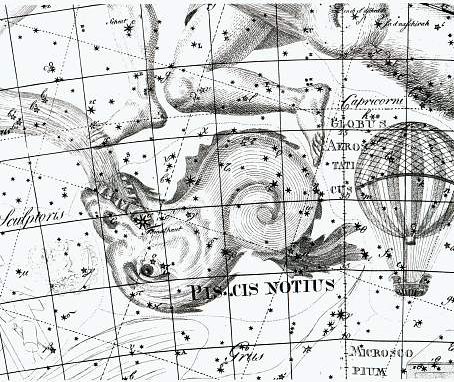 |
|
183 DAYS LATER: |
 |
 |
 |
 |
 |
|
Gb4-15 (229 + 106) |
Gb4-16 (4 * 84) |
Gb4-17 (444 - 107) |
Gb4-18 (2 * 169) |
Gb4-19 |
|
Oct 24 |
25 (*218) |
26 |
27 (300 = 117 + 183) |
28 |
|
°Oct 20 |
21 (*214) |
22 (295 = 112 + 183) |
23 |
24 |
|
'Sept 27 (270) |
28 |
29 (*192) |
(3 * 91) |
'Oct 1 |
|
(16 * 16 = 256) |
"Sept 14 |
15 (*178) |
16 |
17 (260) |
|
OBSERVED CLOSE TO
THE FULL MOON: |
|
No star listed (34) |
ξ Arietis (35.0),
ρ Ceti (35.4),
12 Trianguli
(35.8), ξ² Ceti
(35.9)
*360.0 = *35.4 -
*41.4 = *177 + *183
|
σ Ceti (36.9) |
ν Ceti (37.9) |
ν Arietis (38.5), δ,
ε Ceti (38.8)) |
Fom-al-haut was culminating in the
night leading to Gb4-17 and perhaps
Adhil and Dramasa were at Bb4-17.
Here number play will result in 355
(= 400 - 45):
|
4 * 17 |
41 * 7 |
|
68 |
287 |
|
355 |
|
 |
|
ki to vae oho |
ma te tara huki |
a rere te manu |
ki to vaha kai |
ma te hoko huki -
kua rere te manu |
 |
 |
 |
 |
 |
|
... In China, every
year about the
beginning of April,
certain officials
called Sz'hüen
used of old to go
about the country
armed with wooden
clappers. Their
business was to
summon the people
and command them to
put out every fire.
This was the
beginning of the
season called
Han-shih-tsieh,
or 'eating of cold
food'. For three
days all household
fires remained
extinct as a
preparation for the
solemn renewal of
the fire, which took
place on the fifth
or sixth day after
the winter solstice
[Sic!] ... |
|
Bb4-14 (5 + 130) |
Bb4-15 (136) |
Bb4-16 (421 + 137) |
Bb4-17 |
Bb4-18 (560) |
|
Oct 5 (148 + 130) |
6 |
7 (280) |
8 |
9 |
|
...
Curiously the spine
of a human consists
of 7 neck bones, 12
dorsal bones and 5
tail bones, 24
vertebra in all.
Certainly this was
noticed very early
and thereafter
incorporated into
the myths, whenever
suitable. 5 tail
bones (although no
tail was visible
outside the human
body) must
correspond to the 5
extra days at the
end of the year (not
visible in the
calendar) ...
 |
|
APAMI-ATSA (Child of
Waters) = θ Virginis,
ψ
Hydrae (198.5),
DIADEM = α Com. Ber.
(198.9) |
AL DAFĪRAH (Tuft) =
β
Com. Ber.
(199.4)
*158.0 = *199.4 -
*41.4 |
σ Virginis (200.4)
*159.0 = *200.4 -
*41.4 |
γ
Hydrae (201.0),
ι
Centauri (201.4)
*160.0 = *201.4 -
*41.4 |
Al Simāk-12 (Lofty)
/
Chitra-14 (Bright
One) /
Horn-1 (Crocodile) /
Sa-Sha-Shirū-20
(Virgin's Girdle) /
ANA-ROTO-3 (Middle
pillar)
MIZAR = ζ Ursae
Majoris (202.4),
SPICA = α Virginis,
ALCOR = 80 Ursae
Majoris
(202.7)
SADALMELIK (α
Aquarii)
*161.0 = *202.4 -
*41.4 |
|
... Proclus informs
us that the fox star
nibbles continuously
at the thong of the
yoke which holds
together heaven and
earth; German
folklore adds that
when the fox
succeeds, the world
will come to its
end. This fox star
is no other than
Alcor, the small
star g near zeta
Ursae Majoris (in
India Arundati,
the common wife of
the Seven Rishis,
alpha-eta Ursae ...
 |
|
CLOSE TO THE FULL
MOON: |
|
April 6 (80 + 16 =
96) |
7 (*382) |
(363 + 100 = 355 +
108) |
9 (99 = 464) |
10 (465) |
|
Al Batn Al Hūt-26
(Belly of the Fish)
/
Revati-28
(Prosperous) /
1-iku (Field
Measure)
MIRACH (Girdle) =
β
Andromedae, KEUN MAN
MUN (Camp's South
Gate) =
φ
Andromedae (16.0),
ANUNITUM =
τ
Piscium (16.5),
REVATI (Abundant) =
ζ
Piscium (16.9)
REGULUS
(α Leonis) |
ν Phoenicis (17.4),
κ Tucanae (17.6)
*341.0 = *382.4 -
*41.4
= *158.0 + *183.0 |
No star listed (18) |
ADHIL (Garment's
Train) = ξ
Andromedae
(19.3),
θ
Ceti (19.7) |
KSORA (Knee) =
δ
Cassiopeiae
(20.1),
ω
Andromedae (20.6),
γ
Phoenicis (20.8) |
|
... Though Andromeda
has its roots most
firmly in the Greek
tradition, a female
figure in
Andromeda's place
appeared in
Babylonian
astronomy. The stars
that make up Pisces
and the middle
portion of modern
Andromeda formed a
constellation
representing a
fertility goddess,
sometimes named as
Anunitum or
the Lady of the
Heavens ...
 |
|
FEBR 1 (397) |
2 |
3 |
(464 - 64 = 400) |
5 |
|
ε Equulei (317.8) |
No star listed (318) |
21h (319.6)
ARMUS =
η
Capricorni
(319.0),
DORSUM =
θ
Capricorni
(319.3),
TSOO = 24 Capricorni
(319.7) |
DRAMASA =
σ
Oct.,
χ
Capricorni (320.0),
ν
Aquarii (320.3),
γ
Equulei (320.6),
ο
Pavonis (320.8) |
α
Oct. (321.5),
δ
Equulei (321.7),
φ
Capricorni (321.8) |
|
... Ancient
references to a
south pole are of
course infrequent;
Ovid, howevever,
makes Phoebus allude
to it in his
instructions to
Phaëton ... and
Pliny tells us that
the Hindus had given
it a name,
Dramasa ...
 |
Considering the number of
glyphs on side a of the B
tablet, one of several ways to perceive
421 is to add 121 + 300.
121 = May 1, and 365 - 121 =
4 * 61 (= 121 + 123).
...
Beltane is mentioned in
some of the earliest Irish
literature and it is
associated with important
events in Irish mythology.
It marked the beginning of
summer and was when cattle
were driven out to the
summer pastures. Rituals
were performed to protect
the cattle, crops and
people, and to encourage
growth. Special bonfires
were kindled, and their
flames, smoke and ashes were
deemed to have protective
powers. The people and their
cattle would walk around the
bonfire, or between two
bonfires, and sometimes leap
over flames or embers. All
household fires would be
doused and then re-lit from
the Beltane bonfire. Doors,
windows, byres and the
cattle themselves would be
decorated with yellow May
flowers, perhaps because
they evoked fire. In parts
of Ireland, people would
make a May Bush; a thorn
bush decorated with flowers,
ribbons and bright shells.
Holy wells were also
visited, while Beltane dew
was thought to bring beauty
and maintain youthfulness
...
... Since
the early 20th century it
has been commonly accepted
that Old Irish Beltaine
is derived from a Common
Celtic *belo-te(p)niâ,
meaning 'bright fire'. The
element *belo- might
be cognate with the English
word bale (as in
bale-fire) meaning 'white'
or 'shining'; compare Old
English bael, and
Lithuanian/Latvian
baltas/balts, found in
the name of the Baltic; in
Slavic languages byelo
or beloye also means
'white', as in
Беларусь
(White Russia or Belarus) or
Бе́лое
мо́ре
(White Sea). A more recent
etymology by Xavier
Delamarre would derive it
from a Common Celtic
*Beltinijā, cognate with
the name of the Lithuanian
goddess of death Giltinė,
the root of both being
Proto-Indo-European
*gelH- ('suffering,
death') ...
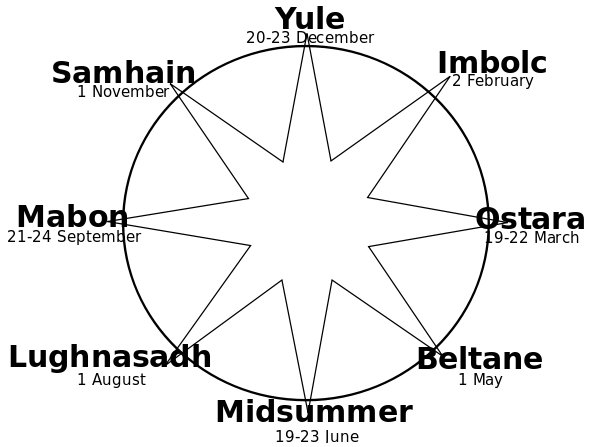
|
Febr 2 (33) |
Aug 1 (213) |
|
181 |
|
May 1 (121) |
Nov 1 (305) |
|
185 |

|




























